Benefits and Costs of a Community-Led Total Sanitation Intervention in Rural Ethiopia—A Trial-Based Ex Post Economic Evaluation
Abstract
1. Introduction
2. Materials and Methods
2.1. Study Area
2.2. Intervention
2.3. Study Design
2.4. Benefit Measurements
2.4.1. Health Benefits
2.4.2. Time Savings from Increased Accessibility to a Household Latrine
2.5. Cost Measurements
2.6. Sensitivity Analyses
3. Results
4. Discussion
5. Conclusions
Supplementary Materials
Author Contributions
Funding
Acknowledgments
Conflicts of Interest
References
- UN. Transforming Our World: The 2030 Agenda for Sustainable Development; United Nations: New York, NY, USA, 2015. [Google Scholar]
- WHO/UNICEF. Progress on Household Drinking Water, Sanitation and Hygiene 2000–2017: Special Focus on Inequalities; World Health Organization: Geneva, Switzerland, 2019. [Google Scholar]
- Kar, K.; Chambers, R. CLTS Handbook; Plan UK: London, UK, 2008; Available online: https://www.communityledtotalsanitation.org/resource/handbook-community-led-total-sanitation (accessed on 27 June 2020).
- Venkataramanan, V.; Crocker, J.; Karon, A.; Bartram, J. Community-Led Total Sanitation: A Mixed-Methods Systematic Review of Evidence and Its Quality. Environ. Health Perspect. 2018, 126, 026001. [Google Scholar] [CrossRef] [PubMed]
- Chambers, R.; Bongartz, P.; Greaves, F.; Mukherjee, N.; Sanan, D. An Open Letter in Response to the World Development Report 2015; Institute of Development Studies: Brighton, UK, 2015; Available online: https://www.communityledtotalsanitation.org/blog/open-letter-response-world-development-report-2015 (accessed on 27 June 2020).
- Bongartz, P.; Vernon, N.; Fox, J. Sustainable Sanitation for All; Practical Action Publishing: Rugby, UK, 2016; Available online: https://practicalactionpublishing.com/book/2130/sustainable-sanitation-for-all (accessed on 27 June 2020).
- Bartram, J.; Charles, K.; Evans, B.; O’Hanlon, L.; Pedley, S. Commentary on community-led total sanitation and human rights: Should the right to community-wide health be won at the cost of individual rights? J. Water Health 2012, 10, 499–503. [Google Scholar] [CrossRef]
- Tyndale-Biscoe, P.; Bond, M.; Kidd, R. Open Defecation Free Sustainability Study; Plan International: Surrey, UK, 2013; Available online: https://www.communityledtotalsanitation.org/sites/communityledtotalsanitation.org/files/Plan_International_ODF_Sustainability_Study.pdf (accessed on 27 June 2020).
- FMOH. Implementing Guideline for CLTSH Programming; Federal Ministry of Health: Addis Ababa, Ethiopia, 2012.
- Drummond, M.F.; Sculpher, M.J.; Claxton, K.; Stoddart, G.L.; Torrance, G.W. Methods for the Economic Evaluation of Health Care Programmes, 4th ed.; Oxford University Press: Oxford, UK, 2015. [Google Scholar]
- Whittington, D.; Jeuland, M.; Barker, K.; Yuen, Y. Setting Priorities, Targeting Subsidies among Water, Sanitation, and Preventive Health Interventions in Developing Countries. World Dev. 2012, 40, 1546–1568. [Google Scholar] [CrossRef]
- Hutton, G.; Chase, C. The Knowledge Base for Achieving the Sustainable Development Goal Targets on Water Supply, Sanitation and Hygiene. Int. J. Environ. Res. Public Health 2016, 13, 536. [Google Scholar] [CrossRef] [PubMed]
- Hutton, G. Global costs and benefits of reaching universal coverage of sanitation and drinking-water supply. J. Water Health 2013, 11, 1–11. [Google Scholar] [CrossRef] [PubMed]
- Hutton, G. Benefits and Costs of the Water, Sanitation and Hygiene Targets for the Post-2015 Development Agenda: Post-2015 Consensus; Copenhagen Consensus Center: Copenhagen, Denmark, 2015; Available online: https://www.copenhagenconsensus.com/sites/default/files/water_sanitation_assessment_-_hutton.pdf (accessed on 27 June 2020).
- Hutton, G.; Haller, L.; Bartram, J. Global cost-benefit analysis of water supply and sanitation interventions. J. Water Health 2007, 5, 481–501. [Google Scholar] [CrossRef]
- Radin, M.; Jeuland, M.; Wang, H.; Whittington, D. Benefit-cost analysis of community-led total sanitation: Incorporating results from recent evaluations. J. Benefit Cost Anal. 2020, 1–38. [Google Scholar] [CrossRef]
- Hutton, G.; Rodriguez, U.-P.; Winara, A.; Nguyen, V.; Kov, P.; Chuan, L.; Blackett, I.; Weitz, A. Economic efficiency of sanitation interventions in Southeast Asia. J. Water Sanit. Hyg. Dev. 2014, 4, 23. [Google Scholar] [CrossRef]
- Whittington, D.; Hanemann, W.M.; Sadoff, C.; Jeuland, M. The challenge of improving water and sanitation services in less developed countries. Found. Trends Microecon. 2009, 4, 469607. [Google Scholar] [CrossRef]
- Ferro, G.; Lentini, E.; Mercadier, A. Economies of scale in the water sector: A survey of the empirical literature. J. Water Sanit. Hyg. Dev. 2011, 1, 179–193. [Google Scholar] [CrossRef]
- Weis, D.; Hutton, G.; Kumar, M. Health costs and benefits from a pilot rural sanitation intervention in India. J. Water Sanit. Hyg. Dev. 2019, 9, 129–138. [Google Scholar] [CrossRef]
- WSP-Africa. Study for Financial and Economic Analysis of Ecological Sanitation in Sub-Saharan Africa; Water and Sanitation Program-Africa: Nairobi, Kenya, 2009; Available online: https://documents.worldbank.org/en/publication/documents-reports/documentdetail/772771468003000076/study-for-financial-and-economic-analysis-of-ecological-sanitation-in-sub-saharan-africa (accessed on 27 June 2020).
- Whittington, D. Benefits and Costs of the Water, Sanitation and Hygiene Targets for the Post-2015 Development Agenda: Post-2015 Consensus; Copenhagen Consensus Center: Copenhagen, Denmark, 2015; Available online: https://www.copenhagenconsensus.com/sites/default/files/was_perspective_-_whittington_1.pdf (accessed on 27 June 2020).
- Whittington, D.; Radin, M.; Jeuland, M. Evidence-based policy analysis? The strange case of the randomized controlled trials of community-led total sanitation. Oxford Rev. Econ. Pol. 2020, 36, 191–221. [Google Scholar] [CrossRef]
- Jung, S.; Doh, Y.A.; Bizuneh, D.B.; Beyene, H.; Seong, J.; Kwon, H.; Kim, Y.; Habteyes, G.N.; Tefera, Y.; Cha, S. The effects of improved sanitation on diarrheal prevalence, incidence, and duration in children under five in the SNNPR State, Ethiopia: Study protocol for a randomized controlled trial. Trials 2016, 17, 204. [Google Scholar] [CrossRef] [PubMed]
- Cha, S.; Jung, S.; Bizuneh, D.B.; Abera, T.; Doh, Y.A.; Seong, J.; Schmidt, W.-P. Effect of a community-led total sanitation intervention on child diarrheal incidence and prevalence in a rural area of the SNNPR state, Ethiopia: A cluster-randomized controlled trial. Am. J. Trop. Med. Hyg. 2020. Accepted pending revisions. [Google Scholar]
- SNNPR. Demographic and Health Statistics Report of SNNPR; Southern Nations, Nationalities, and Peoples’ Regional Office: Hawassa, Ethiopia, 2014; Ethiopian year: 2007. [Google Scholar]
- Glennerster, R.; Takavarasha, K. Running Randomized Evaluations: A Practical Guide; Princeton University Press: New Jersey, NJ, USA, 2013. [Google Scholar]
- Wilkinson, T.; Sculpher, M.J.; Claxton, K.; Revill, P.; Briggs, A.; Cairns, J.A.; Teerawattananon, Y.; Asfaw, E.; Lopert, R.; Culyer, A.J.; et al. The International Decision Support Initiative Reference Case for Economic Evaluation: An Aid to Thought. Value Health 2016, 19, 921–928. [Google Scholar] [CrossRef]
- Robinson, L.A.; Hammitt, J.K.; Cecchini, M.; Chalkidou, K.; Claxton, K.; Cropper, M.; Eozenou, P.H.-V.; de Ferranti, D.; Deolalikar, A.B.; Guanais, F. Reference Case Guidelines for Benefit-Cost Analysis in Global Health and Development; Harvard University: Boston, MA, USA, 2019; Available online: https://cdn1.sph.harvard.edu/wp-content/uploads/sites/2447/2019/05/BCA-Guidelines-May-2019.pdf (accessed on 27 June 2020).
- Husereau, D.; Drummond, M.; Petrou, S.; Carswell, C.; Moher, D.; Greenberg, D.; Augustovski, F.; Briggs, A.H.; Mauskopf, J.; Loder, E.; et al. Consolidated Health Economic Evaluation Reporting Standards (CHEERS) Statement. Value Health 2013, 16, e1–e5. [Google Scholar] [CrossRef]
- Naghavi, M.; Abajobir, A.A.; Abbafati, C.; Abbas, K.M.; Abd-Allah, F.; Abera, S.F.; Aboyans, V.; Adetokunboh, O.; Afshin, A.; Agrawal, A.; et al. Global, regional, and national age-sex specific mortality for 264 causes of death, 1980–2016: A systematic analysis for the Global Burden of Disease Study 2016. Lancet 2017, 390, 1151–1210. [Google Scholar] [CrossRef]
- Robinson, L.A.; Hammitt, J.K.; O’Keeffe, L. Valuing Mortality Risk Reductions in Global Benefit-Cost Analysis. J. Benefit Cost Anal. 2019, 10, 15–50. [Google Scholar] [CrossRef]
- The World Bank. GNI Per Capita, Atlas Methods (US$ and International $); World Bank: Washington, DC, USA, 2020; Available online: https://data.worldbank.org/indicator/NY.GNP.PCAP.CD?locations=ET (accessed on 27 June 2020).
- Whittington, D.; Cook, J. Valuing Changes in Time Use in Low- and Middle-Income Countries. J. Benefit Cost Anal. 2019, 10, 51–72. [Google Scholar] [CrossRef]
- Tilahun, H.; Fekadu, B.; Abdisa, H.; Canavan, M.; Linnander, E.; Bradley, E.H.; Berman, P. Ethiopia’s health extension workers use of work time on duty: Time and motion study. Health Policy Plan. 2017, 32, 320–328. [Google Scholar] [CrossRef]
- Canavan, M.E.; Linnander, E.; Ahmed, S.; Mohammed, H.; Bradley, E.H. Unit Costing of Health Extension Worker Activities in Ethiopia: A Model for Managers at the District and Health Facility Level. Int. J. Health Policy Manag. 2017, 7, 394–401. [Google Scholar] [CrossRef]
- Mangham-Jefferies, L.; Mathewos, B.; Russell, J.; Bekele, A. How do health extension workers in Ethiopia allocate their time? Hum. Resour. Health 2014, 12. [Google Scholar] [CrossRef]
- WHO/UN-Water. Investing in Water and Sanitation: Increasing Access, Reducing Inequalities; GLAAS 2014 Special Report for Africa; World Health Organization: Geneva, Switzerland, 2014. [Google Scholar]
- WHO/UN-Water. TrackFin Initiative: Tracking Financing to Sanitation, Hygiene and Drinking-Water at the National Level; World Health Organization: Geneva, Switzerland, 2017. [Google Scholar]
- KOICA. Basic Design Study: Water, Sanitation and Hygiene Project in SNNPR State, Ethiopia; Korea International Cooperation Agency: Seongnam, Korea, 2014.
- SNNPR. Community-Led Accelerated Wash Project Annual Performance Report; Southern Nations, Nationalities, and Peoples’ Regional Office (Water and Irrigation Development Bureau): Hawassa, Ethiopia, 2018. [Google Scholar]
- Hutton, G.; Bartram, J. Global costs of attaining the Millennium Development Goal for water supply and sanitation. Bull. World Health Organ. 2008, 86, 13–19. [Google Scholar] [CrossRef] [PubMed]
- Nyarko, K.B.; Buamah, R.; Nunoo, F.K.N.; Appiah-Effah, E.; Afful, K.M.; Samwini, N.A.; Owusu-Boakye, A. Latrine Technology Manual; United Nations Children’s Fund Ghana: Accra, Ghana, 2016; Available online: https://www.susana.org/en/knowledge-hub/resources-and-publications/library/details/3313 (accessed on 27 June 2020).
- Hutton, G. Financial and Economic Impacts of the Swachh Bharat Mission in India; United Nations Children’s Fund India: New Delhi, India, 2017; Available online: https://www.unicef.org/india/reports/financial-and-economic-impacts-swachh-bharat-mission-india (accessed on 27 June 2020).
- WRC. Design and Operating Requirements to Optimize the Life Span of VIP Toilets: WRC Report 1630/1/07; Water Research Commission: Pretoria, South Africa, 2007. [Google Scholar]
- Nakagiri, A.; Niwagaba, C.B.; Nyenje, P.M.; Kulabako, R.N.; Tumuhairwe, J.B.; Kansiime, F. Are pit latrines in urban areas of Sub-Saharan Africa performing? A review of usage, filling, insects and odour nuisances. BMC Public Health 2016, 16. [Google Scholar] [CrossRef] [PubMed]
- Still, D.; Foxon, K. Tackling the Challenges of Full Pit Latrines. How Fast Do Pit Toilets Fill Up? A Scientific Understanding of Sludge Build Up and Accumulation in Pit Latrines; WRC Report 1745/2/12; Water Research Commission: Pretoria, South Africa, 2012. [Google Scholar]
- Todman, L.C.; van Eekert, M.H.A.; Templeton, M.R.; Hardy, M.; Gibson, W.T.; Torondel, B.; Abdelahi, F.; Ensink, J.H.J. Modeling the fill rate of pit latrines in Ifakara, Tanzania. J. Water Sanit. Hyg. Dev. 2014, 5, 100–106. [Google Scholar] [CrossRef]
- Nakagiri, A.; Kulabako, R.N.; Nynje, P.M.; Tumuhairwe, J.B.; Niwagaba, C.B.; Kansiime, F. Performance of pit latrines in urban poor areas: A case of Kampala, Uganada. Habitat Int. 2015, 49, 529–537. [Google Scholar] [CrossRef]
- Foxon, K. Scientific Support for the Design and Operation of Ventilated Improved Pit Latrines (VIPS); School of Chemical Engineering University of KwaZulu-Natal: Durban, South Africa, 2008. [Google Scholar]
- Crocker, J.; Saywell, D.; Bartram, J. Sustainability of Community-Led Total Sanitation Outcomes: Evidence From Ethiopia and Ghana. Int. J. Hyg. Environ. Health 2017, 220, 551–557. [Google Scholar] [CrossRef]
- Null, C.; Stewart, C.P.; Pickering, A.J.; Dentz, H.N.; Arnold, B.F.; Arnold, C.D.; Benjamin-Chung, J.; Clasen, T.; Dewey, K.G.; Fernald, L.C.H. Effects of water quality, sanitation, handwashing, and nutritional interventions on diarrhoea and child growth in rural Kenya: A cluster-randomised controlled trial. Lancet Glob. Health 2018, 6, e316–e329. [Google Scholar] [CrossRef]
- Pickering, A.J.; Djebbari, H.; Lopez, C.; Dentz, H.N.; Arnold, B.F.; Arnold, C.D.; Benjamin-Chung, J.; Clasen, T.; Dewey, K.G.; Fernal, L.C.H. Effect of a community-led sanitation intervention on child diarrhoea and child growth in rural Mali: A cluster-randomised controlled trial. Lancet Glob. Health 2015, 3, e701–e711. [Google Scholar] [CrossRef]
- Patil, S.R.; Arnold, B.F.; Salvatore, A.L.; Briceno, B.; Ganguly, S.; Colford, J.M., Jr.; Gertler, P.J. The effect of India’s total sanitation campaign on defecation behaviors and child health in rural Madhya Pradesh: A cluster randomized controlled trial. PLoS Med. 2014, 11, e1001709. [Google Scholar] [CrossRef] [PubMed]
- Clasen, T.; Boisson, S.; Routray, P.; Torondel, B.; Bell, M.; Cumming, O.; Ensink, J.; Freeman, M.; Jenkins, M.; Odagiri, M. Effectiveness of a rural sanitation programme on diarrhoea, soil-transmitted helminth infection, and child malnutrition in Odisha, India: A cluster-randomised trial. Lancet Glob. Health 2014, 2, e645–e653. [Google Scholar] [CrossRef]
- Luby, S.P.; Rahman, M.; Arnold, B.F.; Unicomb, L.; Ashraf, S.; Winch, P.J.; Stewart, C.P.; Begum, F.; Hussain, F.; Benjamin-Chun, J. Effects of water quality, sanitation, handwashing, and nutritional interventions on diarrhea and child growth in rural Bangladesh: A cluster randomized controlled trial. Lancet Glob. Health 2018, 6, e302–e315. [Google Scholar] [CrossRef]
- Wolf, J.; Hunter, P.R.; Freeman, M.C.; Cumming, O.; Clasen, T.; Bartram, J.; Higgins, J.P.T.; Johnston, R.; Medlicott, K.; Boisson, S. Impact of drinking water, sanitation and handwashing with soap on childhood diarrhoeal disease: Updated meta-analysis and meta-regression. Trop. Med. Int. Health 2018, 23, 508–525. [Google Scholar] [CrossRef] [PubMed]
- Freeman, M.C.; Garn, J.V.; Sclar, G.D.; Boisson, S.; Medlicott, K.; Alexander, K.T.; Penakalapati, G.; Anderson, D.; Mahtani, A.G.; Grimes, J.E.T. The impact of sanitation on infectious disease and nutritional status: A systematic review and meta-analysis. Int. J. Hyg. Environ. Health 2017, 220, 928–949. [Google Scholar] [CrossRef]
- Kar, K. Scaling-Up Community Led Total Sanitation: From Village to Nation; Practical Action: Rugby, UK, 2019. [Google Scholar]
- Chavasse, D.C.; Shier, R.P.; Murphy, O.A.; Huttly, S.R.; Cousens, S.N.; Akhtar, T. Impact of fly control on childhood diarrhoea in Pakistan: Community-randomised trial. Lancet 1999, 2, 22–25. [Google Scholar] [CrossRef]
- Burton, M.J.; Mabey, D. The global burden of trachoma: A review. PLoS Negl. Trop. Dis. 2009, 3, e460. [Google Scholar] [CrossRef]
- Pullan, R.; Smith, J.; Jasrasaria, R.; Brooker, S. Global numbers of infection and disease burden of soil-transmitted helminth infections in 2010. Parasites Vectors 2014, 7, 37. [Google Scholar] [CrossRef] [PubMed]
- Brooker, S.; Clements, A.; Bundy, D. Global epidemiology, ecology and control of soil-transmitted helminth infections. Adv. Parasitol. 2006, 62, 221–261. [Google Scholar]
- WHO. Working to Overcome the Global Impact of Neglected Tropical Diseases: First WHO Report on Neglected Tropical Diseases; World Health Organization: Geneva, Switzerland, 2010. [Google Scholar]
- Humphrey, J. Child undernutrition, tropical enteropathy, toilets, and handwashing. Lancet 2009, 3754, 1032–1035. [Google Scholar] [CrossRef]
- Kotloff, K.; Nataro, J.; Blackwelder, W.; Nasrin, D.; Farag, T.; Panchalingam, S.; Wu, Y.; Sow, S.; Sur, D.; Breiman, R. Burden and aetiology of diarrhoeal disease in infants and young children in developing countries (the global enteric multicenter study, gems): A prospective, case-control study. Lancet 2013, 382, 209–222. [Google Scholar] [CrossRef]
- Salazar-Lindo, E.; Allen, S.; Brewster, D.; Elliott, E.; Fasano, A.; Phillips, A.; Sanderson, I.; Tarr, P. Intestinal infections and environmental enteropathy: Working group report of the second world congress of pediatric gastroenterology, hepatology, and nutrition. J. Pediatr. Gastroenterol. Nutr. 2004, 39, S662–S669. [Google Scholar] [CrossRef]
- Guerrant, R.; DeBoer, M.; Moore, S.; Scharf, R.; Lima, A. The impoverished gut-A triple burden of diarrhoea, stunting and chronic disease. Nat. Rev. Gastroenterol. Hepatol. 2013, 10, 220–229. [Google Scholar] [CrossRef] [PubMed]
- Cairncross, S. The Case for Marketing Sanitation. Field Note; Water and Sanitation Program; World Bank: Washington, DC, USA, 2004. [Google Scholar]
- Fisher, J. For Her It’s the Big Issue. Putting Women at the Centre of Water Supply, Sanitation and Hygiene; Evidence Report; Water Supply and Sanitation Collaborative Council: Geneva, Switzerland, 2006. [Google Scholar]
- Jenkins, M.; Scott, B. Behavioral indicators of household decision-making and demand for sanitation and potential gains from social marketing in Ghana. Soc. Sci. Med. 2007, 64, 2427–2442. [Google Scholar] [CrossRef] [PubMed]
- Jasper, C.; Le, T.; Bartram, J. Water and sanitation in schools: A systematic review of the health and educational outcomes. Int. J. Environ. Res. Public Health 2012, 9, 2272–2287. [Google Scholar] [CrossRef] [PubMed]
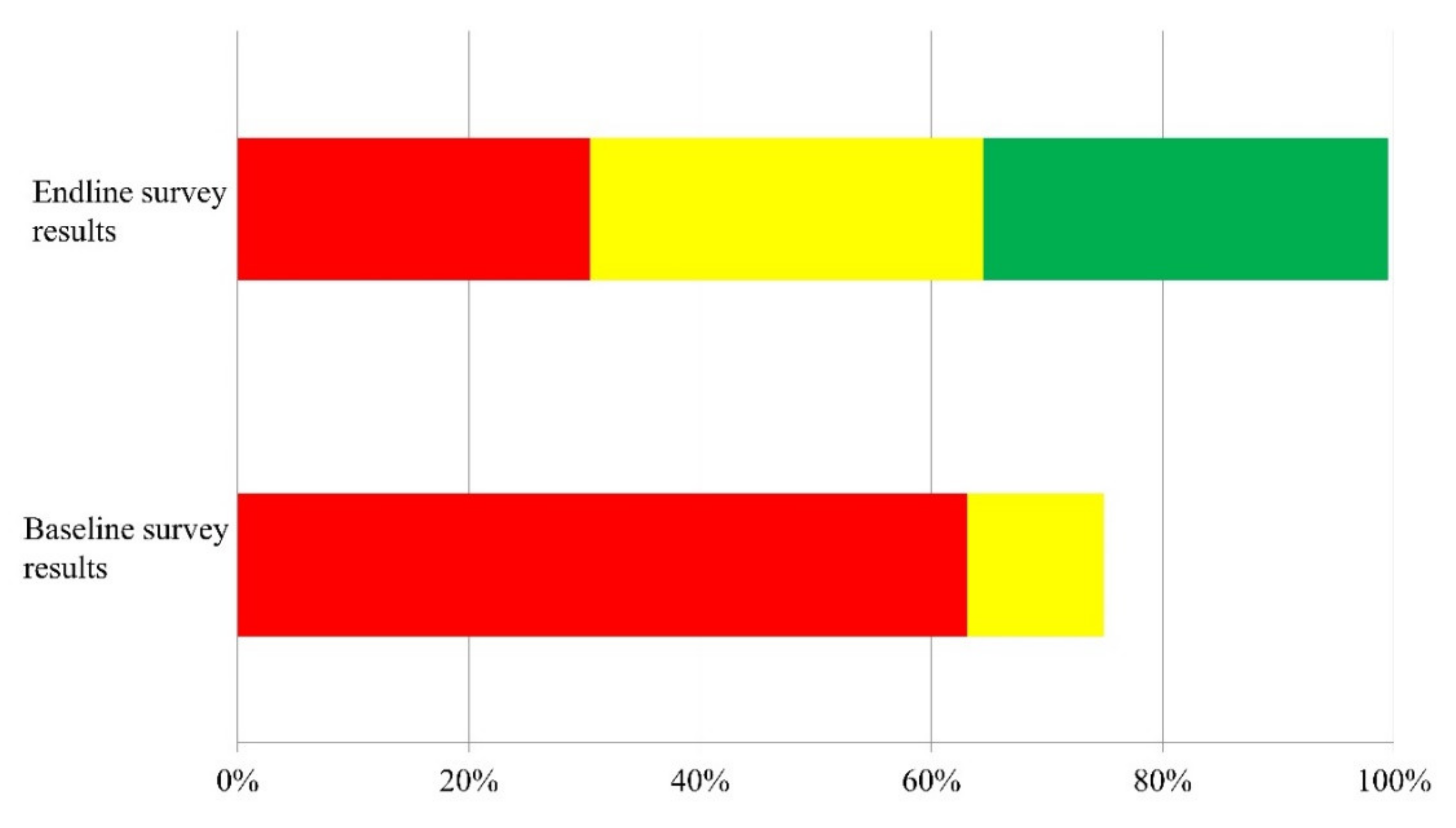
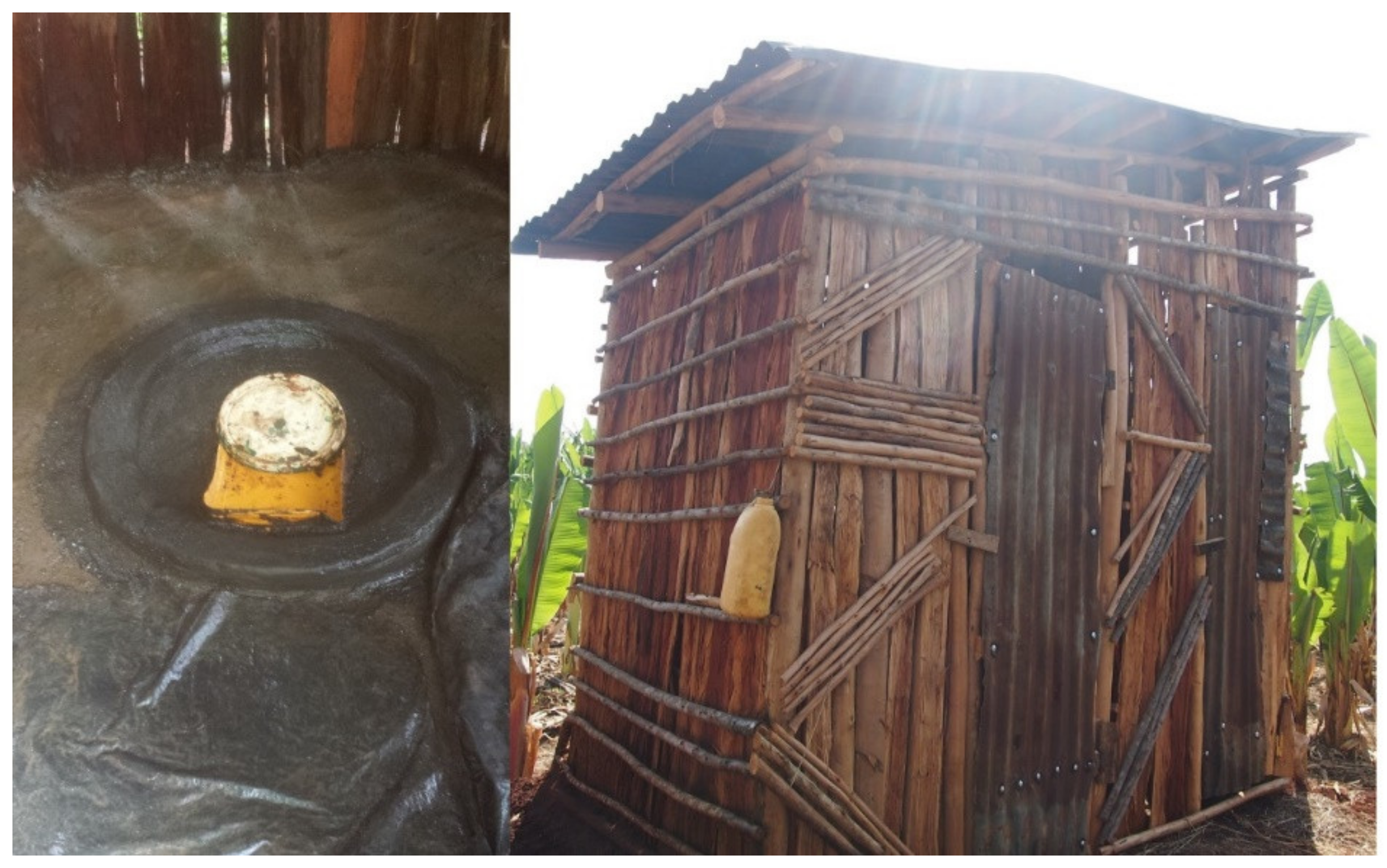
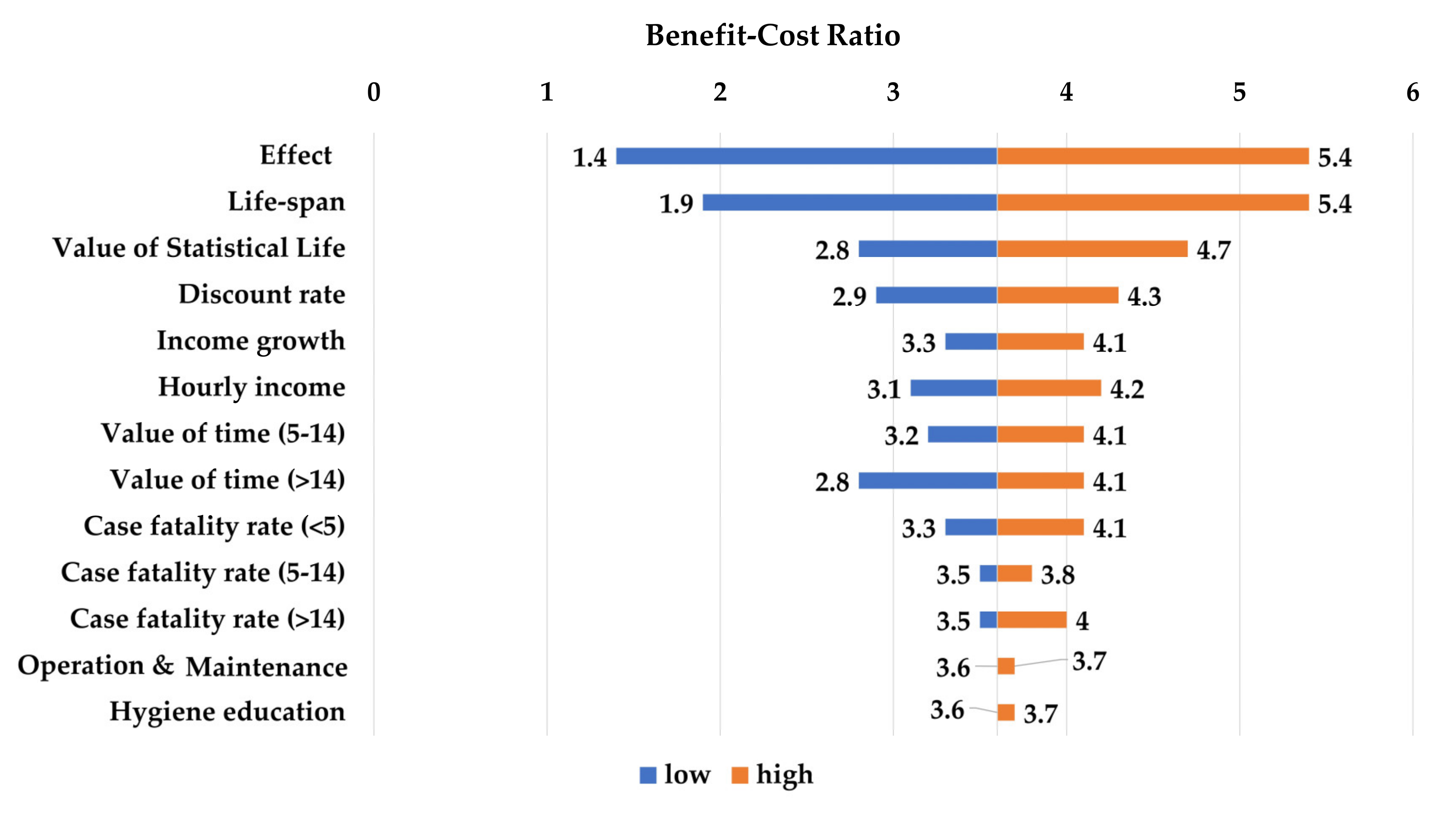
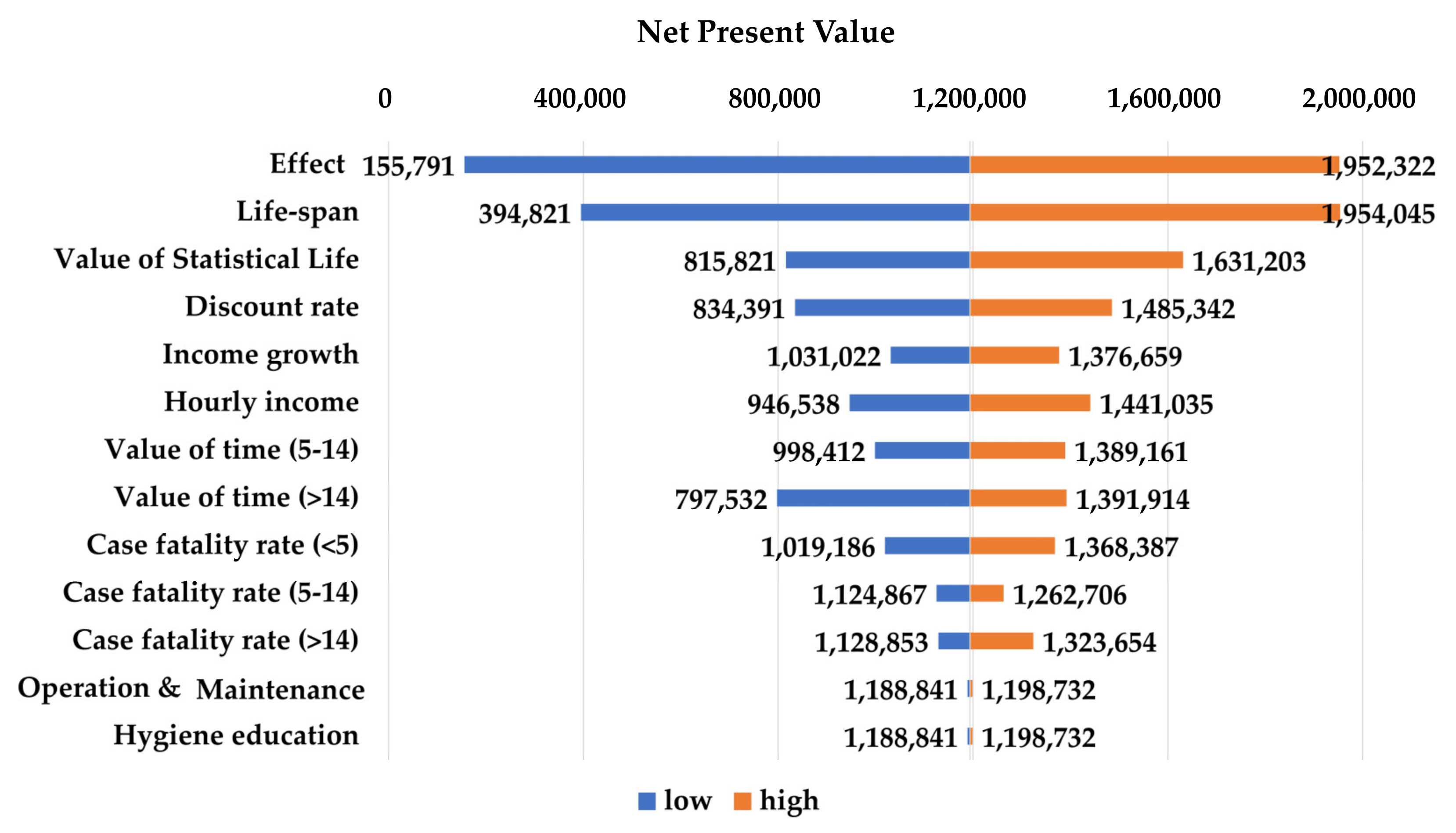
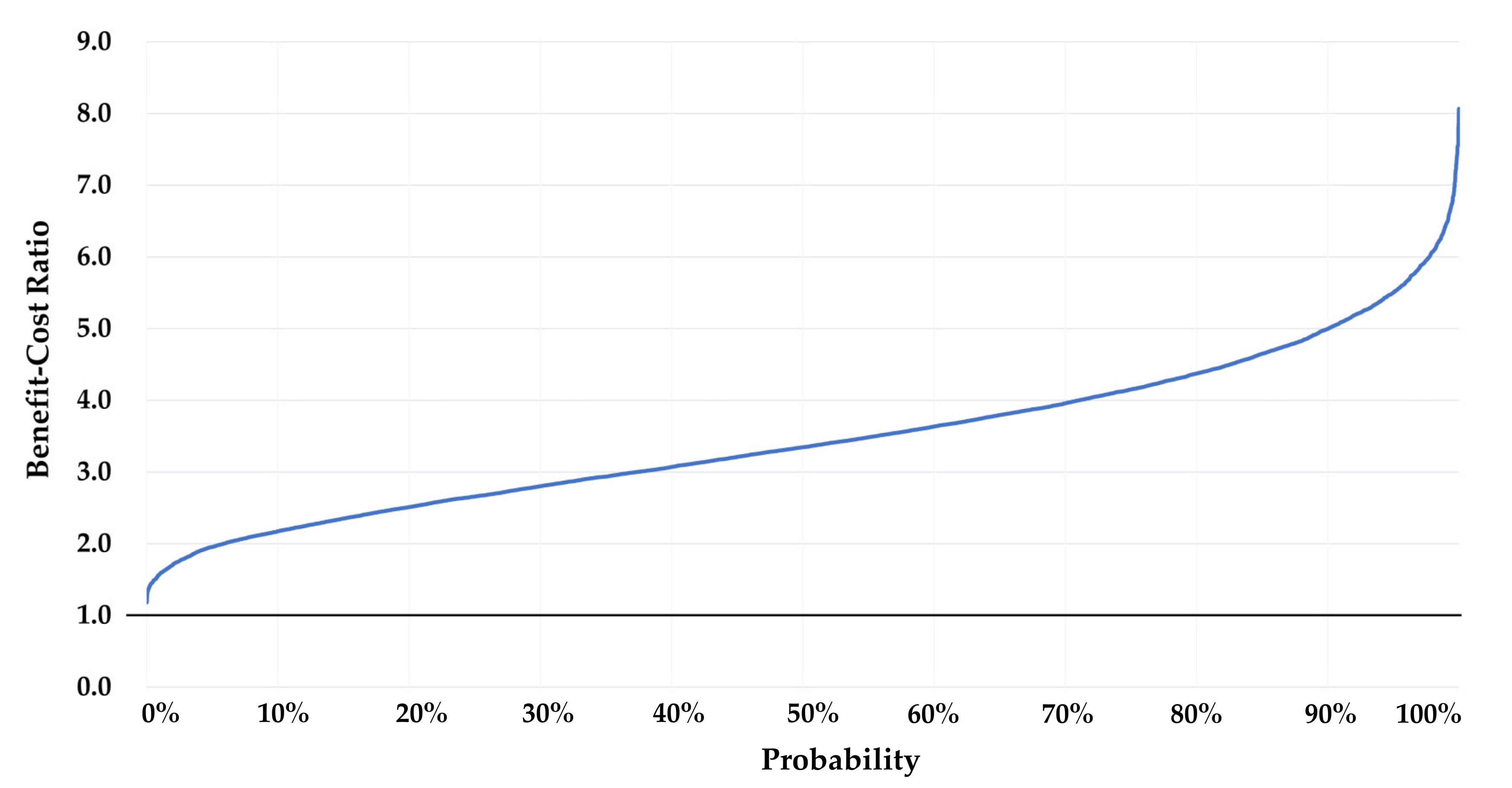
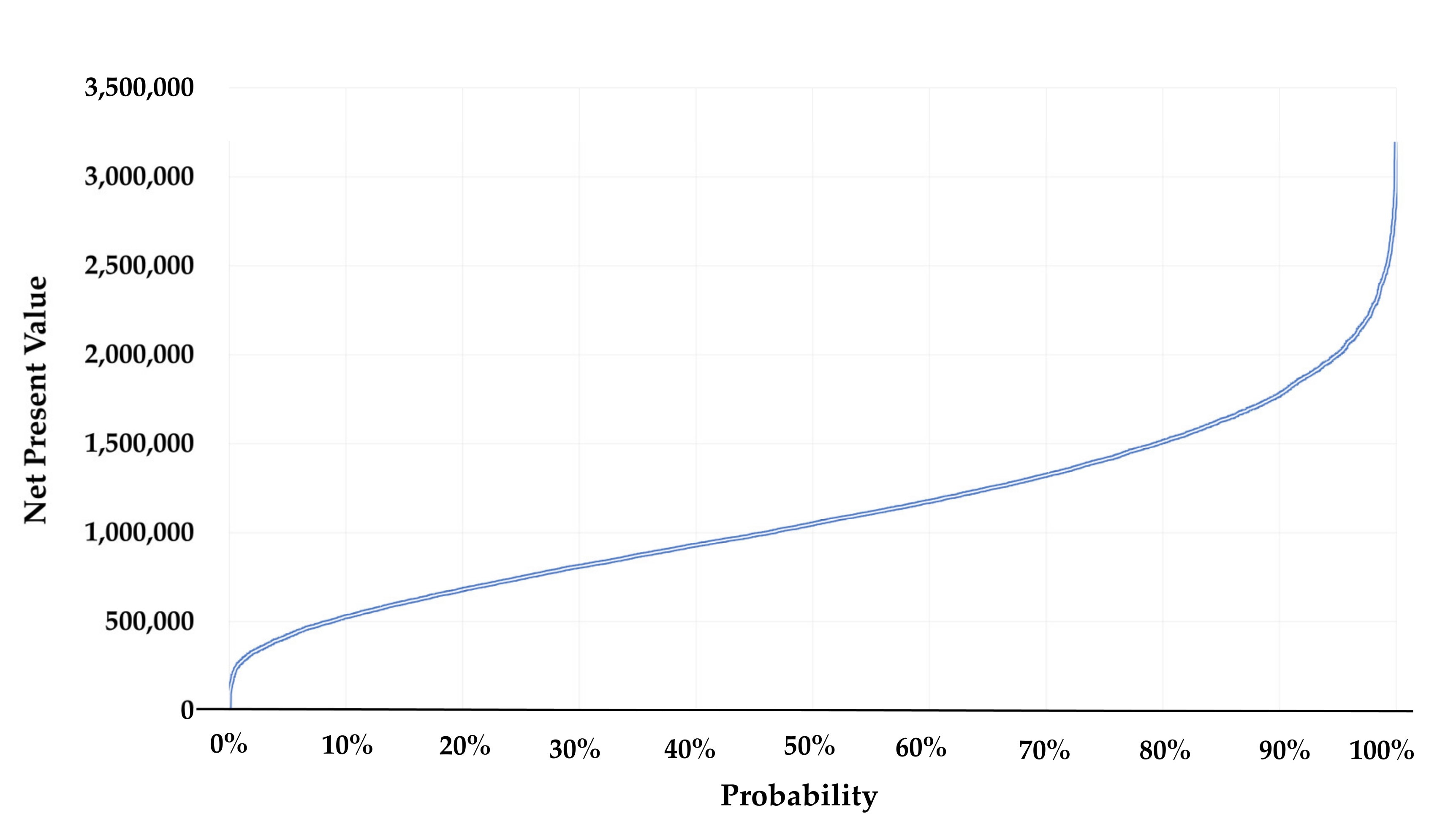
| Intervention | Control | |
|---|---|---|
| Total days of diarrhoea | 481 | 773 |
| Number of children | 409 | 433 |
| Person-days | 49,571 | 52,467 |
| Effect of CLTS on longitudinal prevalence of child diarrhoea (Reduced days of child diarrhoea per year) * | 1.6 days, 95% Confidence Interval: 0.2–2.6 days p = 0.03 |
| <5 | 5–14 | 15 | SUM | |
|---|---|---|---|---|
| Diarrhoea cases avoided | 20,374 | 16,084 | 15,154 | 51,612 |
| Premature deaths averted | 14 | 3 | 5 | 22 |
| Time saved from taking care of sick people (hours) | 162,989 | 128,673 | 121,231 | 412,893 |
| Time saved from the switch to a household latrine (hours) | 0 | 1,101,556 | 963,346 | 2,064,902 |
| Item | Age Group | ||||||
|---|---|---|---|---|---|---|---|
| <5 | 5–14 | 15 | Subtotal | % | |||
| Benefits | Avoided diarrhoea cases | Treatment costs saved | 3294 | 1305 | 1230 | 5829 | 13% |
| Transportation costs saved | 3386 | 2312 | 2178 | 7876 | |||
| Meal costs saved | 903 | 465 | 439 | 1807 | |||
| Accommodation costs saved | 337 | 97 | 130 | 564 | |||
| Caregiver time saved | 51,769 | 20,435 | 38,506 | 110,709 | |||
| Health professionals’ time saved | 63,003 | 12,477 | 11,756 | 87,236 | |||
| Subtotal | 122,692 | 37,091 | 54,239 | 214,021 | |||
| Averted premature deaths | Value of statistical life | 611,103 | 137,839 | 194,801 | 943,744 | 58% | |
| Time saved from increased accessibility | Switch from open defecation | 0 | 33,469 | 118,927 | 152,396 | 29% | |
| Switch from using communal latrines | 0 | 46,949 | 91,930 | 138,878 | |||
| Switch from using neighbours’ latrines | 0 | 94,521 | 95,124 | 189,645 | |||
| Subtotal | 0 | 174,939 | 305,981 | 480,919 | |||
| Total | 733,795 (45%) | 349,869 (21%) | 555,021 (34%) | 1,638,684 (100%) | 100% | ||
| Costs | Initial costs | ||||||
| Project implementation and management | Recurrent | 223,845 | 54% | ||||
| capital | 14,580 | ||||||
| Subtotal | 238,425 | ||||||
| Investment of community and local stakeholders | Recurrent | 102,353 | 42% | ||||
| capital | 84,337 | ||||||
| Subtotal | 186,690 | ||||||
| Subtotal of initial costs | 425,115 | ||||||
| Operation and maintenance Education for the lifespan of a latrine | Operation and maintenance | 9,892 | 4% | ||||
| Education | 9,892 | ||||||
| Subtotal | 19,784 | ||||||
| Total | 444,899 | 100% | |||||
| Benefit–Cost Ratio (BCR) | 3.7 | ||||||
| Net Present Value (NPV) | 1,193,786 (49,741 per community; 687 per household) | ||||||
| Item | Cost | ||
|---|---|---|---|
| CLTS a Implementation | Recurrent | CLTS promoter introduction | 1200 |
| CLTS promoter training | 2160 | ||
| Educating mothers | 2160 | ||
| Community campaign | 1800 | ||
| Information, Education and Communication Materials | 9000 | ||
| Best promoter prize | 2670 | ||
| CLTS training | 5355 | ||
| CLTS implementation | 2651 | ||
| Experience sharing | 720 | ||
| Material incentives | 3840 | ||
| Monitoring/follow-up after the CLTS triggering | 43,204 | ||
| Meeting/workshop | 4800 | ||
| Subtotal | 79,560 | ||
| Project Management | Capital | Motorcycle | 5,590 |
| Vehicle | 8,990 | ||
| Subtotal | 14,580 | ||
| Recurrent | Korean staff salary and benefits | 78,000 | |
| Local management staff salary and benefits | 24,840 | ||
| Translator | 3600 | ||
| Stationery | 4520 | ||
| Drivers | 4800 | ||
| Fuel | 12,000 | ||
| Office | 3600 | ||
| Monitoring and evaluation | 8925 | ||
| Report printing | 4000 | ||
| Subtotal | 144,285 | ||
| Subtotal | Recurrent | 223,845 (94%) | |
| Capital | 14,580 (6%) | ||
| Total | 238,425 (100%) | ||
| Item | Participants | Number of People | Hours/Person | Hourly Income a | Cost | |
|---|---|---|---|---|---|---|
| Recurrent c | CLTS b training | District health officials | 5 | 56 | 4.50 | 1260 |
| Health professionals (health centre) | 5 | 56 | 2.54 | 711 | ||
| Health extension workers | 24 | 56 | 1.79 | 2400 | ||
| CLTS promoter training | CLTS promoters | 38 | 32 | 0.67 | 817 | |
| CLTS orientation | District health officials | 3 | 8 | 4.50 | 108 | |
| CLTS promoters | 38 | 8 | 0.67 | 204 | ||
| CLTS triggering | District health officials | 5 | 40 | 4.50 | 900 | |
| Health extension workers | 24 | 192 | 2.54 | 11,704 | ||
| CLTS promoters | 38 | 304 | 0.67 | 7740 | ||
| Community members | 804 | 8 | 0.67 | 4311 | ||
| CLTS follow-up | District health officials | 5 | 256 | 4.50 | 5760 | |
| Health extension workers | 24 | 256 | 1.79 | 10,998 | ||
| CLTS promoters | 38 | 512 | 0.67 | 13,036 | ||
| CLTS committee | 72 | 128 | 0.67 | 6175 | ||
| Community members | 1079 | 32 | 0.67 | 23,127 | ||
| Kebele leaders | 24 | 64 | 0.67 | 1029 | ||
| Review meeting | District health officials | 12 | 64 | 4.50 | 3456 | |
| Health extension workers | 24 | 64 | 2.54 | 3901 | ||
| CLTS promoters | 38 | 64 | 0.67 | 1629 | ||
| CLTS committee | 72 | 64 | 0.67 | 3087 | ||
| Subtotal | - | - | - | - | 102,353 (55%) | |
| Capital d | Latrine construction (time) | Community people | 872 | 120 | 0.67 | 70,107 |
| Latrine construction (cement) | Community people | 71 | - | 27.90 | 1968 | |
| Latrine construction (handwashing facility) | Community people | 721 | - | 17.01 | 12,263 | |
| Subtotal | - | - | - | - | 84,337 (45%) | |
| Total | - | - | - | - | 186,690 (100%) | |
© 2020 by the authors. Licensee MDPI, Basel, Switzerland. This article is an open access article distributed under the terms and conditions of the Creative Commons Attribution (CC BY) license (http://creativecommons.org/licenses/by/4.0/).
Share and Cite
Cha, S.; Jung, S.; Belew Bizuneh, D.; Abera, T.; Doh, Y.-A.; Seong, J.; Ross, I. Benefits and Costs of a Community-Led Total Sanitation Intervention in Rural Ethiopia—A Trial-Based Ex Post Economic Evaluation. Int. J. Environ. Res. Public Health 2020, 17, 5068. https://doi.org/10.3390/ijerph17145068
Cha S, Jung S, Belew Bizuneh D, Abera T, Doh Y-A, Seong J, Ross I. Benefits and Costs of a Community-Led Total Sanitation Intervention in Rural Ethiopia—A Trial-Based Ex Post Economic Evaluation. International Journal of Environmental Research and Public Health. 2020; 17(14):5068. https://doi.org/10.3390/ijerph17145068
Chicago/Turabian StyleCha, Seungman, Sunghoon Jung, Dawit Belew Bizuneh, Tadesse Abera, Young-Ah Doh, Jieun Seong, and Ian Ross. 2020. "Benefits and Costs of a Community-Led Total Sanitation Intervention in Rural Ethiopia—A Trial-Based Ex Post Economic Evaluation" International Journal of Environmental Research and Public Health 17, no. 14: 5068. https://doi.org/10.3390/ijerph17145068
APA StyleCha, S., Jung, S., Belew Bizuneh, D., Abera, T., Doh, Y.-A., Seong, J., & Ross, I. (2020). Benefits and Costs of a Community-Led Total Sanitation Intervention in Rural Ethiopia—A Trial-Based Ex Post Economic Evaluation. International Journal of Environmental Research and Public Health, 17(14), 5068. https://doi.org/10.3390/ijerph17145068





